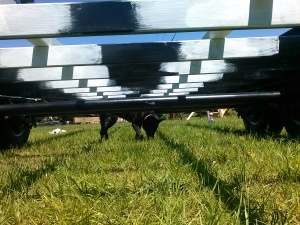I can’t even guess how many times we’ve been back and forth to Lowe’s and Home Depot… part of the trouble with having no idea what we’re doing is that we often omit some crucial component from our shopping list, or run out of material, or break a tool…we’re definitely making slow but sure progress, and most of the time it’s even fun (hopefully our neighbors aren’t too sensitive to curse words)!
Aluminum flashing
As I mentioned in the last post, we built the floor frame in three main sections. We decided that flashing each piece independently would be a lot easier than the alternative — connecting them together, lifting and flipping over the entire frame, and flashing it as one giant piece. We’re adding pieces of overlap flashing at the joints between the major sections… unfortunately, this meant that we didn’t buy quite enough flashing and were delayed another couple of days (we don’t get much work done outside the weekends, since Rob has an actual 9-5ish job).
Doing the flashing is not too difficult (we’re using 20″ wide aluminum rolls)… but it’s maybe impossible to get it totally flat. It’s especially bubbly in the middle section of floor, which was apparently very slightly off square when we screwed in the flashing — when we hammered it into place between the two end pieces, the flashing went a little crazy. Hopefully it won’t matter too much… we have a 2″ overlap between sheets, and the rigid foam insulation should diminish any serious bubbles.
Attaching the frame to the trailer
We’re using a couple of different attachments to permanently affix the house to the trailer. Our trailer has handy 1/8″ thick flanges running along the side which provide our main attachment points. We’re using 3/8″ x 1 1/2″ lag screws to come up through the flange into the wood. These go along each side, except in the wheel well section.
Second, we’re using L-bracket strong-ties to attach each joist to the two main steel decking beams that run the length of the trailer. We’re alternating directions on these (or more accurately, applying them in random directions based on where it’s easier to sit).
Now, some handy advice I wish we had had before starting to drill (thanks YouTube)… steel trailers are really hard to drill through. These few things will make your life so much easier:
- Use the right drill bit! I highly recommend a cobalt one (titanium was pretty much useless). We bought a second after breaking the first…
- Go slowly — it seemed like using high RPMs would speed up the process, but it doesn’t.
- Use a drilling fluid!! We didn’t buy anything fancy — we just put a little motor oil in a water bottle and poked a small hole in the top. Instantly made drilling 100x faster.
You may have noticed that we haven’t leveled our trailer yet… because of the brilliant way we decided to attach the scissor jacks, leveling at this stage would be pointless — our bolts need to go through not only the trailer, but also the floor framing, subfloor, and steel studs. Yay us! Hopefully leveling once we get the subfloor on won’t present a problem.




















